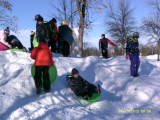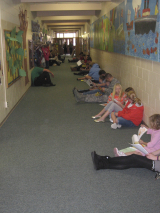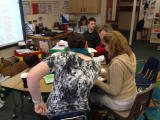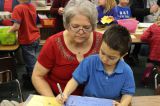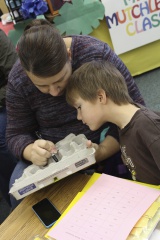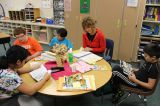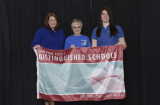-
Category 1
Selected in 2013
-
Grades: pre k - 5
School Setting: rural
Town Population: 67
Student Enrollment: 340
Student Demographics:
Black/African American: 2%
Teacher/Student Ratio: 1:20
White/Caucasian: 88%
Hispanic: 5%
Hawaiian/Pacific Islander: 0.1%
Asian: 0.9%
Native American: 4%
Other: 0%
% Reduced Lunch: 40%
% ELL Learners: 0%
Founded: 1960 -
PRINCIPAL:
Dr. Beth Randklev -
CONTACT:
1016 South 20th Street
Grand Forks, ND 58201
701-746-2250
brandklev@gfschools.org
Ben Franklin Elementary
Grand Forks, ND
We have a monthly "RED" event. RED stands for Read Every Day. On the last half hour of the last Friday of every month, we invite parents (and grandparents, older siblings, University students, etc) to come and read with/to our students. This ensures that this is a day that ALL of us read!
- Describe specific programs in place to ensure that families are involved in the success of your school and students.
- Our students meet their teachers before school gets out each spring. Then before school starts we have an open house for parents and students to come and meet their teachers. In the spring, we hold an orientation for parents where parents meet with kindergarten teachers one-on-one or in small groups. We continue to hold "make-up" sessions throughout the summer ensuring that all parents attend a session. We hold two sets of parent/teacher/student conferences each year. On the last half hour of the last Friday of each month we hold a RED event where parents and/or grandparents come and read with their student. Each grade level provides a parent learning event each year where parents are invited to come and learn ways they can support their child's learning at home. Exit slips from each session help our teachers to plan for future events that will meet the needs of parents.
- Describe the most successful activity your school has initiated to strengthen ties to your community.
-
We have a monthly "RED" event. RED stands for Read Every Day. On the last half hour of the last Friday of every month, we invite parents (and grandparents, older siblings, University students, etc) to come and read with/to our students. This ensures that this is a day that ALL of us read! Students love having someone come and read with them. Family members love to come and read. Readers are found in the hallways and classrooms all over the school. An average of 220 "guest readers" attend each RED event.
The other activity that we have initiated is Parent Learning Events. Every grade level invites parents to come and learn something about that grade level and ways that parents can help at home. Activities include: making sight word games, learning partial sums, how to pick a "just right book," and how to use online resources. Parents are presented an "exit slip" at the end of each learning event and these slips help us plan the next event. - Describe your philosophy of school change or improvement.
- When there is a need for change, and people are united in the "mission" of an organization, change/improvement becomes a way of life. We embarked on change because our students were not achieving. This caused us to have to work differently. We developed a set of commitment statements, one of which is that we have adopted "kaizen" -- continuous improvement forever. In our school, decisions are made based on the what is best for the learning of the students. Period. When that is the purpose of change, people will work together and sacrifice their own preferences for the good of the school. Schools are "learning organizations" and everyone should have the chance to learn, grow, and develop so that they can be more successful. Schools should look back on changes and see improvement and be able to say, "We did this together."
- What are your school’s top two goals for the next year?
- All goals include having all students reach their benchmark reading level as measured by the Fountas and Pinnell assessment. (Last year, 95% or more of our students in grades K-4, and 93% of our students in the 5th grade made their benchmark.) We also have the goal that our students in grades 2-5 will make their target goal as measured on NWEA's Measure of Educational Progress (MAP). Further, we have the school goal that we will "make" AYP in both reading and math.
- What is the single most important factor in the success of your school that others could replicate?
- We formed a Professional Learning Community following the template of the DuFours. We have identified the 6 characteristics that identify a professional learning community and have worked to develop each to a high degree -- including the importance of beginning with clearly establishing a vision, mission, values, and goals. We believe that it is critical that this is what "drives" a school, and is not simply "an exercise." Further, we have studied and developed Response to Intervention as a way to answer the 3rd critical question of a Professional Learning Community, "what do you do when you students haven't learned." We read the book, "Delivering on the Promise" about the Kennewick, WA school district and also followed replicated their work. A single factor that we believe would really help others is to "level" reading and math groups -- whether in grade level teams or in multi-aged groups. We believe that replicating this factor would help other schools be more successful.
- Describe the program or initiative that has had the greatest positive effect on student achievement, including closing achievement or opportunity gaps, if applicable.
- "Leveling" our groups to provide "targeted" instruction in the areas of reading and math has had the biggest impact on student performance. As our poverty level increased, so has our achievement. This is due to assessing our students, and grouping them to meet their needs. We have designed 90 minute reading blocks and 60 minute math blocks. We have increased collaboration to three times per week: once with the reading specialists and principal in grade level teams, once where all teams meet together to work on common curriculum/issues, and once a week as a "group learning" time. Our lowest groups of students also have the lowest student-teacher ratio and often have "push in" services which has resulted in "catch up" growth. We have "built capacity" in our staff members who have developed instructional techniques and strategies to meet the unique needs of each group of learners.
- Explain how Title I funds are used to support your improvement efforts.
- Title I funds provide salaries for two amazing reading specialists (1.5 FTEs). We have hired 1.5 para educators who provide "push in" services to our lowest reading reading groups. They also administer research-based interventions to identified students and progress monitor those students weekly. We have purchased additional IWBs in order to have one in each classroom. We have purchased ipads and applications to provide additional literacy skill development and support literacy center work. We have purchased research-based intervention materials. We have also purchased additional teacher resources. Our reading specialists and principal attended a conference sponsored by the University of Arkansas in order to provide additional staff development for teachers. We purchased materials for our parent learning events so that parents can use them to help their children at home.
- Identify the critical professional development activities you use to improve teaching and student learning.
- We have established one day a week after school as our "group learning" time. We have studied books together. We had one of our instructional coaches lead many learning sessions. Our reading specialists have "modeled lessons" in classrooms and have helped us develop "common language" with students. We have shared resources and watched videos together. Currently our reading specialists are providing "job embedded, just-in-time" information during our weekly grade level meetings. We have also had teachers learn a variety of things, and teach and share them with the staff. We have worked to "build capacity" within members of our staff -- encouraging them to develop expertise in areas of interest.
- Describe how data is used to improve student achievement and inform decision making.
- Our reading specialist maintains a data "grid" that is available to all of us. We include information from multiple sources color-coding it for ease of use and to show patterns in our students. Each grade level team meets weekly for 30 minutes with the reading specialists and principal. We examine data and discuss student progress. Three times a year (after benchmark data are collected) we meet for 90 minutes and make decisions about grouping students, providing interventions, etc. Our leveled groups are "fluid" and changes can be made at any time based on data. If students are receiving an intervention, we use progress-monitoring data to determine if the intervention is effective or needs to be changed. This also helps us celebrate successes -- with each other and with the students. We show students how they are doing on the various assessments so they also can set goals and celebrate their success. Data are also shared with parents (and students) to set goals.
- Describe your school culture and explain changes you’ve taken to improve it.
- Our school culture is highly collaborative, professional and positive. We built a vision statement to become "Mayo elementary" in 2005 and that idea (patterned after Mayo Clinic in Rochester, MN--a world famous medical facility) guides our work to provide high quality service to our students. We "built" a set of commitment statements that guide our work. We meet as grade level teams. We collaborate around data and make decisions that maximize learning. As part of this culture, we see ourselves as contributing to our profession by helping develop future teachers. Like a teaching hospital, we provide placements for students in pre-service, student teaching, and the graduate level. These students work along side us -- making us better at what we do. In 2012, our school was named the demonstration school for the state of North Dakota for developing future teachers in effective practices. We continually strive to be better.
Stats
-
Category 1
Selected in 2013
-
Grades: pre k - 5
School Setting: rural
Town Population: 67
Student Enrollment: 340
Student Demographics:
Black/African American: 2%
Teacher/Student Ratio: 1:20
White/Caucasian: 88%
Hispanic: 5%
Hawaiian/Pacific Islander: 0.1%
Asian: 0.9%
Native American: 4%
Other: 0%
% Reduced Lunch: 40%
% ELL Learners: 0%
Founded: 1960 -
PRINCIPAL:
Dr. Beth Randklev -
CONTACT:
1016 South 20th Street
Grand Forks, ND 58201
701-746-2250
brandklev@gfschools.org



